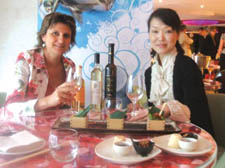|
|
 |
| |

Honami Matsumoto, Cocoon’s sommelier, right, with Christine Molines, France-based general manager of AOC Languedoc |
Sweet smell of success
VIN Doux Natural (VDN), naturally sweet wine, is not well known in the UK. Mainly produced in the Languedoc and Roussillon wine regions of France, its sweetness is obtained by a simple procedure dating back to the 1300s.
Grape spirit is added to the fermenting wine, arresting fermentation and preserving some of the natural sugar that normally turns into alcohol. The results are wines with 15 per cent volume alcohol that burst on the palate with rounded, powerful, long, naturally sweet flavours that linger on the taste buds.
Traditionally served as an aperitif, they go well with foie gras, duck dishes, goat and blue cheeses. With desert they are among the few wines that can stand up to chocolate.
Wines from the four Languedoc VDN areas – all made from 100 per cent Muscat grapes – were on show last week at the Cocoon restaurant in Regent Street. The purpose of the event was to demonstrate how well these wines combine with Asian food such as pan fried gyoza teriyaki, steamed chilli soy, or chicken with satay dressing. The wines we tasted worked best as aperitifs and with Cocoon’s chocolate fondant dessert.
Honami Matsumoto, Cocoon’s Japanese-born sommelier was enthusiastic. She would recommend the wines to her diners as part of a tasting menu, she said. She was also keen to promote sake – Japanese rice wine – as another unusual but very acceptable alternative to the dry, fruity wines that her customers were inclined to order.
Vin Doux Natural (VDN).
A naturally sweet, mainly white wine produced in France.
Grape: Muscat (mainly, Muscat Blanc à Petits Grains)
VDN wines available to buy
and where to find them:
Muscat de Beaumes-de-Venise.
Rhone Valley, France
Nose: Exotic fruits with a hint of roses.
Palate: Intense fresh and rich, citrus fruits, menthol on the finish.
Eat with: Cream desserts, Moroccan food, lemon pies or tarts.
Where stocked: Berry Brothers and Rudd, 3 St James St. SW1A 1EG.
www.bbr.com
Muscat de Frontignan (modern style)
Lanquedoc, France
Nose: Citrus and exotic fruits
Palate: Honey balanced by elegant freshness.
Eat with: As an aperitif or with Blue cheeses.
Where stocked: thesussexwinecompany.co.uk
Muscat de Rivesaltes
Roussillon, France
Nose: Powerful and complex; peach, apricot, grapefruit, floral notes, mint, honey and crystallised fruits.
Palate: Powerful, rounded and fresh; various fruits, honey, high acidity and mint.
Eat with: As an aperitif, foie gras, lemon or orange deserts, strawberries, peaches.
Where stocked: Waitrose.
www.waitrose.com (click through to dessert wine, South of France)
Muscat de Saint-Jean-de-Minervois
Lanquedoc, France.
Nose: Citronella and passion fruit
Palate: lacy and sweet.
Eat with: As an aperitif, blue cheese, sorbets and ice creams.
Where stocked: Sainsburys,
www.sainsburys.com
Muscat du Cap Corse
Corsica, France
Nose: Figs, sultanas, butter, spices,
Palate: fresh juicy grapes , figs, sultanas and some spiciness.
Eat with: as an aperitif, charcuterie, grilled white meat, mousse and fruit salads.
Where stocked: www.yapp.co.uk
Banyuls
Roussillion, France
A red Vin Doux Natural, made from the Granache noir grape.
Nose: Intense and powerful, red fruits, dried fruits, spice. Aromas change as wine ages.
Palate:Powerful tannins, fruit, fresh finish. Taste alters with aging.
Eat With: Grilled wood pigeon, chocolate pudding.
Where Stocked: www.yapp.co.uk |
 |
|
|
 |

|
|
 |
|









